When you buy through our links, we may earn an affiliate commission.
Do you want to develop your skills as a musician without disturbing your neighbors or the people you live with?
A practice amp offers a compact and portable alternative to larger, louder amps without compromising on tone. It should come equipped with a range of features and be designed to maximize the efficiency and enjoyment of your practice sessions––the key to a great practice amp is combining practicality with sound quality.
In this article, we’ve singled out the best practice amps to suit all playing styles, musical genres, and other requirements. We’ve also compiled a detailed buyer’s guide and tips for choosing the best option.
Our top pick is the popular Line 6 Spider V 60 Combo Amp, simply because it’s a great all-rounder loaded with various presets, effects, and features. It's very straightforward to use and produces excellent clean and overdriven tones.
The best practice amp will provide you with the ideal tones, dynamic range, and the features you need for practicing your playing. Let’s check them out!
Quick Summary of the Best Practice Amps
- Line 6 Spider V 60 MkII 1x10 (Best Overall)
- Fender Champion 20 Combo Amp (Best Budget Practice Amp)
- Roland CUBE-10GX COSM Combo Amp (Best Practice Amp for Effects)
- Orange Crush 20 Combo Amp (Best Practice Amp for Metal)
- VOX AC4C1-12 Tube Combo Amp (Best Tube Practice Amp)
- Positive Grid Spark Mini Portable Guitar Combo Amplifier (Best Mini Practice Amp)
- Fender Rumble 25 Bass Combo Amp (Best Bass Practice Amp)
Best Practice Amps
1. Best Overall – Line 6 Spider V 60 MkII 1x10
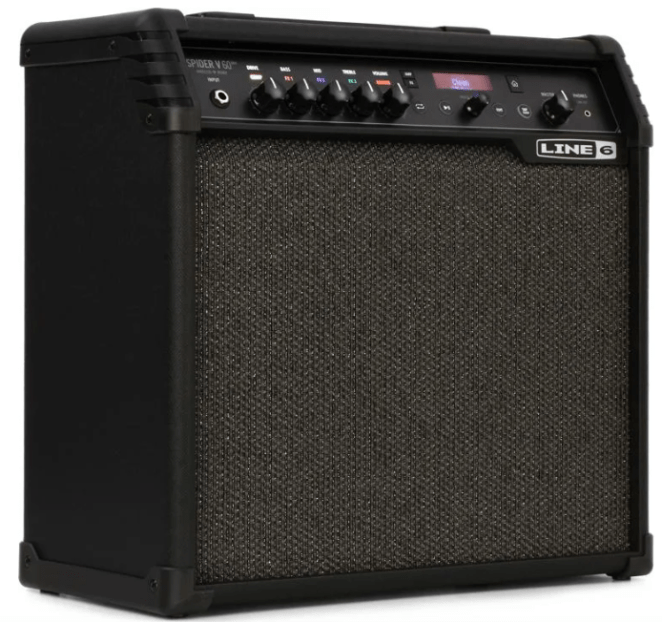
SPECS
- Type: Solid State with Modeling
- Number of Channels: 1
- Speaker: 1 x 10” Woofer, 1 x Tweeter
- Total Power: 60W
Line 6 has built a reputation for being one of the leading designers of modeling guitar amplifiers. I’ve been lucky enough to use several versions of the brand’s famous Spider amps over the years, and I can confidently say that this model is one of the best practice amps available.
Packed with an array of high-quality and diverse presets, the Spider V is suitable for practicing in any style or genre. Something we found very impressive when testing this amp was how many different sounds it can produce, even though the control layout doesn’t feel at all overcrowded or complicated.
It has all of the classic controls, such as drive, EQ, and volume, along with an LCD display that shows which of the 200-plus presets you have selected.
The thing that really sets the Line 6 Spider V apart from the other best practice amps is its wide range of additional features. I was blown away by the efficiency of this device, with its onboard metronome, tuner, and looper all providing invaluable tools for maximizing the efficiency of your practice routine.
Furthermore, the amp is loaded with pre-made drum loops, so you can simulate the experience of playing with a drummer.
Why We Like It:
- With a built-in tuner, metronome, and looper, this amp includes everything you need for practicing guitar.
- The Spider V includes over 200 presets and amp models and can produce every guitar tone imaginable!
- Thanks to its versatile tone and dynamics, this amp is suitable for practicing, recording, or performing live.
2. Best Budget Practice Amp – Fender Champion 20 Combo Amp
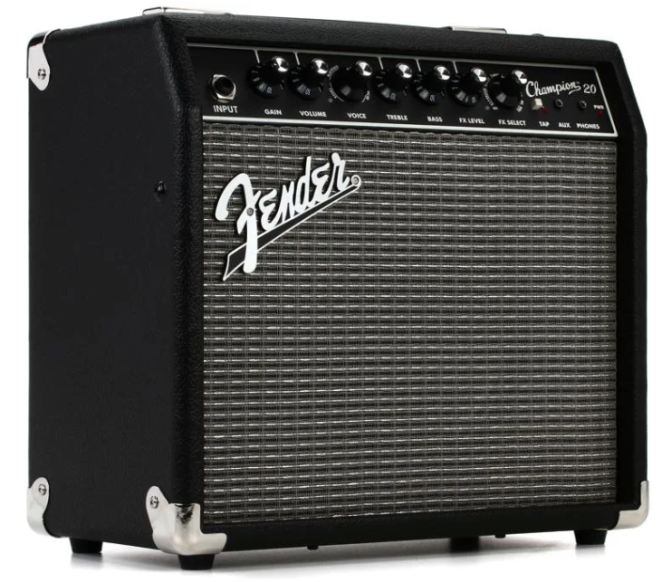
SPECS
- Type: Solid State
- Number of Channels: 1
- Speaker Size: 1 x 8”
- Total Power: 20W
Fender is arguably the most influential and iconic guitar amp manufacturer in history. I’ve had the pleasure of using a variety of Fender amps over the years, from their legendary tube-driven amps to some of the best practice amps, like the excellent Champion 20.
This affordable combo amp provides everything a guitarist needs to improve their skills through consistent practice. It comes with various onboard controls, allowing you to tweak the gain, volume, and EQ or select your preferred voicing and effects.
One of the things that impressed me the most about this amp is the quality of the individual amp voicings that you can choose between. They range from the classic clean tones of modern Fender amp models to the red-hot overdrive of the brand’s vintage tube amps, giving you a wide range of sounds to practice with.
I also found that the array of onboard effects, including the classic reverb and tremolo combination, delay, chorus, and more, led me to practice in different styles than usual.
The different sounds that the amp can create make even the most basic scales and riffs sound exciting, leading to longer, more engaging practices.
Why We Like It:
- This amp's wide range of tones leads to more inspired guitar practice routines.
- The many onboard effects mean you don’t need to rely on pedals when practicing.
- This pedal produces a classic blend of Fender guitar tones from modern and vintage eras.
3. Best Practice Amp for Effects – Roland CUBE-10GX COSM Combo Amp
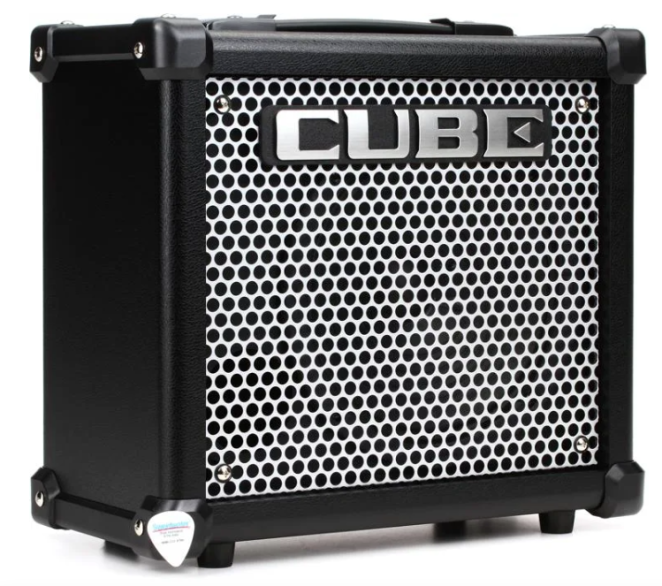
SPECS
- Type: Solid State with Modeling
- Number of Channels: 1
- Speaker Size: 1' x 8”
- Total Power: 10W
The CUBE-10GX is a conveniently sized combo amplifier that is perfect for musicians who need to practice in multiple locations. Designed for maximum portability, this 10-watt combo amp packs a surprising punch for its size and weight.
If you’re the type of musician who loves to experiment with effects, this Roland amp could be one of the best practice amps for you. I’ve had a lot of fun messing around with built-in reverb, chorus, digital delay, and other effects that are built into this device, and I was highly impressed by their studio-level quality.
Combining a solid-state design with modeling technology, this compact amp benefits from an 8” speaker, providing ample practice volume.
I also like that the onboard amp models and presets, which by default consist of clean, crunch, and lead amplifier tones, can be swapped for other options using the innovative CUBE KIT smartphone app.
Why We Like It:
- The portable and lightweight design makes this amp ideal for traveling musicians.
- The amp can be used for playing electric, acoustic, or bass guitar.
- High-quality reverb, delay, and modulation effects are combined with several amp models for tonal variation.
4. Best Practice Amp for Metal – Orange Crush 20 Combo Amp
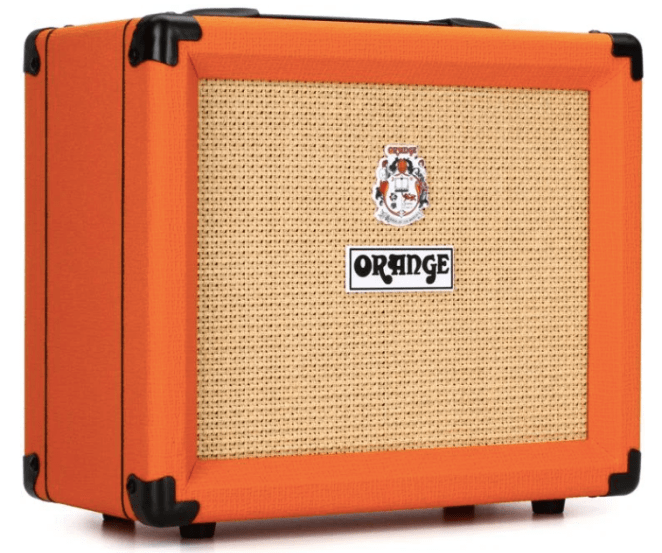
SPECS
- Type: Solid State
- Number of Channels: 2
- Speaker Size: 1 x 8”
- Total Power: 20W
I’ve always admired Orange’s British invasion-style amp models, but the brand is best known for its larger, tube-driven devices, so I was unsure what to expect when I first plugged my guitar into the solid-state Orange Crush 20.
The first thing I noticed was how good the clean setting sounds - you can hear every detail of your playing, which is ideal for practicing.
The inclusion of a 4-stage preamp is a real game changer and is a large part of why this is one of the best practice amps available.
This component expands the tonal capabilities of the Orange Crush 20 exponentially, giving you access to a range of classic tube-style tones that sound like they could have come straight out of a 1960s London recording studio.
With all of the connectivity required for silent practice, including a headphone/line output, this 20-watt combo amp is an excellent all-rounder. Although I wouldn’t recommend using it for live performances in medium or large venues, this practice amp has enough power to be used in more intimate settings.
Why We Like It:
- The 4-stage preamp increases the number of vintage tones this amp can produce.
- This amp accurately emulates classic 4 x 12” Orange cabs from the 1960s and 70s.
- The Orange Crush 20 has a maximum volume that is perfect for practicing with other musicians.
5. Best Tube Practice Amp – VOX AC4C1-12 Tube Combo Amp
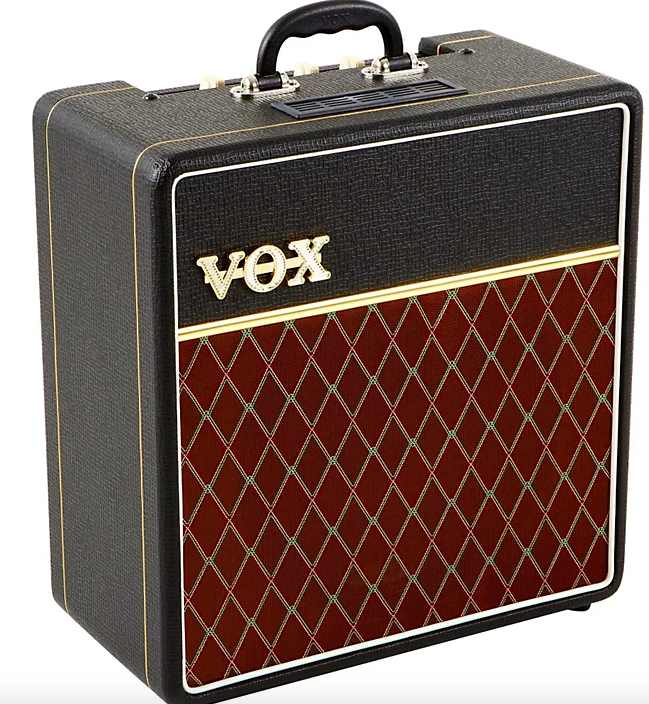
SPECS
- Type: Tube
- Number of Channels: 1
- Speaker Size: 1' x 12”
- Total Power: 4W
Of all the best practice amps we tested, the VOX AC4C1-12 made the greatest impression on us in terms of tone. There’s something about the warm saturation that this small tube amp produces that instantly takes you back to the glory days of rock music.
Finding tube amp models for practicing can be a challenge, as they tend to be significantly heavier than solid-state alternatives.
However, VOX has managed to keep this amp’s weight and dimensions down as much as possible without sacrificing the sound quality that makes this type of amp so appealing to electric guitar players.
I had a lot of fun testing my pedals with this tube amp and discovered that it responds very well to gain-based pedals that push the 12AX7 preamp tubes and the EL84 power tube into overdrive.
This amp’s sound and design are inspired by one of my all-time favorite tube amps, the legendary VOX AC30, and it achieves a very similar tone while being much more suitably sized for practicing.
Why We Like It:
- This amp delivers warm, vintage tube-driven tones ideal for rock music.
- In addition to being a great amp for practicing, it’s also a great choice for recording a guitar at home.
- If you like to use pedals when practicing, this amp provides an excellent clean tone for effects to be added.
6. Best Mini Practice Amp – Positive Grid Spark Mini Portable Guitar Combo Amplifier
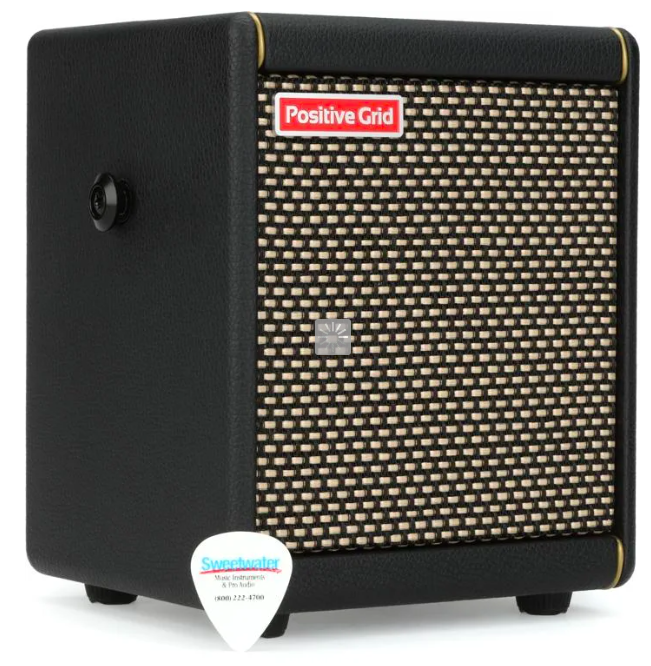
SPECS:
- Type: Solid State
- Number of Channels: 4
- Speaker: 2 x 2”
- Total Power: 10W
Despite being labeled the Spark Mini, this little amp by Positive Grid produces a huge sound. With a pair of two-inch speakers, its frequency response is wide enough to cover the full tonality of an electric or acoustic guitar.
I went through a full practice routine when testing this modeling amp and enjoyed the diversity of the four onboard presets. After working on scales, drills, and exercises, I like to end my practices with a jam, and the Spark Mini made this easy.
Boasting USB connectivity, wireless connectivity via Bluetooth, and several preloaded Smart Jam Live backing tracks, I found it great for practicing soloing and improvisation.
The Positive Grid Spark Mini is lithium battery powered and can be recharged, so you don’t need to play it into a power source. This, along with its lightweight and portable design, makes it perfect for practicing guitar when traveling and offers a great alternative to other practice amps.
Why We Like It:
- This amp is the perfect size and weight to be taken on the road.
- With over 10,000 presets accessible through the Spark Mini app, the tonal possibilities are endless.
- Despite its compact design, the Spark Mini produces more than enough volume for solo practice.
7. Best Bass Practice Amp – Fender Rumble 25 Bass Combo Amp
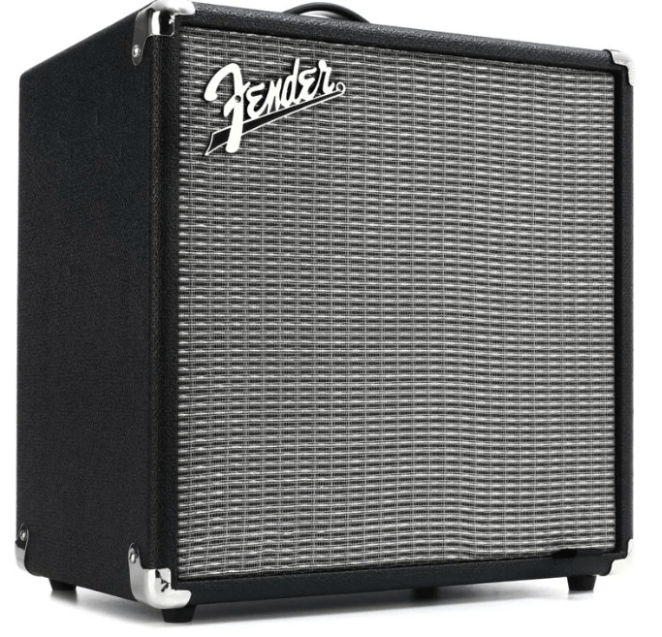
SPECS:
- Type: Solid State
- Number of Channels: 1
- Speaker: 1 x 8”
- Total Power: 25W
At first glance, the Fender Rumble 25 looks like one of the legendary American manufacturers' vintage amps from the 1960s, but being a solid state amp, modern technology has been used to create this 25-watt powerhouse.
One of the best practice amps for bass, the Rumble 25 comes equipped with a 3-band eq so that you can shape your tone precisely.
The aux input was very useful when I wanted to practice playing along to a drum backing track, to work on my timing and groove, or when I was learning a new song and needed to reference it while playing.
In terms of size, I think this Fender amp offers a good balance between power and portability. It’s heavier than most of the practice guitar amps out there, but this is worthwhile for the extra power needed to produce the low-end frequencies of a bass guitar.
Why We Like It:
- The eight-inch speaker delivers a punchy, powerful tone.
- With a headphone output and an aux input, this amp is ideal for practicing without disturbing others.
- The inclusion of overdrive can add some more excitement to your practice.
Best Practice Amps Buyer's Guide
In order to improve as a musician, it’s important to develop a consistent routine of practicing the different aspects of playing your instrument.
For electric guitarists and bassists in particular, practicing unplugged is nowhere near as effective as using a good practicing amp so that you can become accustomed to being amplified in preparation for future performances or recording sessions.
As you can see from the options we’ve recommended in this guide, there are several practice amps that are worth considering.
If you’re yet to make a decision - our buyer’s guide will provide all of the information you need so that you can figure out which one will be most effective for developing your skills as a musician.
We’ll go over the key things you need to look out for when looking at the various amp models and get into some of the important details to help you find the perfect practice amp for your needs.
Wattage and Volume
Practice amps don’t require the high wattage that an amp used for gigging needs to have. The lower the wattage, the lower the amp's maximum volume will be, so choose one that falls within the range of 10-30 watts, depending on where and how you intend to use it. High-power amps generally aren't suitable for quiet playing.
Speaker Size and Quality
The tone of a practice amp is largely determined by the size, quantity, and type of speaker it houses. The ideal size for practice amps is between 6-10 inches. Larger speakers can produce more bass, while smaller ones will be better suited to practicing at low volumes.
Built-in Effects and Features
Many practice amps come with pre-installed effects. The main effects you’re likely to come across are reverb, delay, distortion, and potentially modulation effects like chorus, phasers, or flangers.
These amps may also offer additional features like headphone jacks for silent practice, aux inputs, and outputs for direct recording.
Portability and Size
A good practice amp needs to be portable if you wish to use it in multiple locations. If you’re more likely to keep the amp in one place, you don’t need to worry too much about its size and weight but think about whether you will want to use it for band rehearsals or recordings in the future when considering these aspects.
Solid State, Tube, and Modeling Amps
There are three main categories that practice guitar amps fall into - solid state, modeling, and tube amps. The majority of practice amps are likely to be digital modeling amps or solid state amps, as these two varieties are better suited to compact devices.
A tube amp may produce a desirable vintage tone, but most practice amps need to be small and lightweight, which are two qualities not commonly associated with tube amps. Some small tube amps are available but lack the features a guitar player needs when practicing.
If you use a tube amplifier as your main performance amp when playing guitar, I’d recommend an option like the VOX AC4C1-12 we covered earlier in this article to benefit from the consistency. This will also allow you to test out your pedals to see how they sound through a tube-driven amplifier when practicing.
Rather than using a set of tubes, solid-state amps rely on transistors for the amplification process. This makes them more consistent and predictable than their tube-driven counterparts and significantly reduces their weight.
Solid-state practice amps are an excellent choice for musicians looking for reliable sound quality and versatility.
Modeling practice amps are often loaded with studio-quality effects and can recreate the sounds produced by popular modern and retro-style amps.
A modeling amp uses digital technology to emulate specific tonal and dynamic qualities of other amps, effects, and cab simulations, making them by far the most versatile choice for practicing.
Sound Quality, Power Rating, and Speaker Size
Even if you only intend to use the amplifier for practicing alone, sound quality is still one of the most important qualities to look out for. An amp that doesn’t produce desirable tones will likely discourage you from practicing, leading to less progress in developing your playing.
One of the main determining factors regarding amp sounds and tone quality is the choice and size of the speaker installed in the amp. Smaller amps tend to have one speaker that is between 4” and 10” in diameter, but larger combo amps, like the Line 6 Spider V, have two speakers - a woofer and a tweeter.
A larger speaker is capable of producing a wider frequency range with extended low-end output. They also sound better at high volumes than smaller speakers but are less suited to home practice.
Another important thing to be aware of is the power requirements of a practice amp, as this also significantly impacts the way it sounds. The higher an amp's wattage, the louder its maximum volume, and in most cases, the larger it will be.
Most practice amps are low-wattage devices, as they don’t usually need to reach exceedingly high volumes.
Some amps are designed for street performers and buskers and, therefore, can be powered using eight AA batteries for several hours rather than with a power supply. This is a good option if you want to practice while traveling.
Effects & Connectivity
Some guitarists prefer to practice on a clean channel, making it easier to hear the finer details of their playing and highlight any areas that need improvement. Others, like myself, like to experiment with different effects when practicing, as this can make it more fun and therefore lead to longer, more productive sessions.
It’s not always possible to use your pedals when practicing, especially if you have limited space available. Therefore choosing a solid state amplifier that is loaded with reverb, delay, vibrato, chorus, and so forth is a space-effective alternative that still provides all of the benefits of using a chain of stompboxes to process your guitar’s signal.
Connectivity is another integral aspect of any great practice amp. To avoid any noise complaints, it’s important that the amp has a headphone output. Some amplifiers offer Bluetooth connectivity, which increases your mobility when practicing quietly.
You may also benefit from a home practice amp that can be operated by battery power, such as the Positive Grid Spark Mini, which can be recharged via USB connectivity and lasts for up to 8 hours.
Frequently Asked Questions (FAQs)
What is the main difference between a practice amp and a performance amp?
The most noticeable difference between a practice and performance amp is that the former has a lower power output - commonly in the region of 5 to 30 watts, while amplifiers designed for performing live and playing with a band are likely to have power outputs of between 50 and 100 watts.
Can you use effects pedals with a practice amp?
The majority of effects pedals work perfectly with practice amps, but if the amplifier has a particularly small speaker, certain effects can sound muddy. Driving a lot of gain through a small amp will cause clipping, which is generally not desirable. Likewise, using intense modulation through a practice amp be detrimental to the sound quality.
Can I play an acoustic guitar with a practice amp?
Most practice amps can be used for either electric or acoustic guitar. You may need to tweak the onboard EQ settings and add subtle effects like reverb to get your desired tone, but the amp’s frequency response will likely suit both guitar varieties.
It may be worth considering an acoustic amp like the Roland Cube we discussed earlier in this article if you need one specifically for practicing acoustic guitar.
Final Thoughts
With such a wide range of excellent options available, deciding between the best practice amps 2024 has to offer can be tricky. If you're looking for an amp that can do everything you need to practice guitar and you have enough space available, the Spider V by Line 6 is our top recommendation.
Another excellent option is the Fender Champion 20, which is a reliable and affordable guitar amplifier.
After reading our recommendations, hopefully, you’ve figured out which practice amp will best suit your requirements.
Photo Courtesy Sweetwater & Guitar Center
